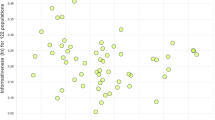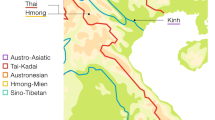Abstract
The publication of a haplotype tree of human mitochondrial DNA variation in 1987 provoked a controversy about the details of recent human evolution that continues to this day. Now many haplotype trees are available, and new analytical techniques exist for testing hypotheses about recent evolutionary history using haplotype trees. Here I present formal statistical analysis of human haplotype trees for mitochondrial DNA, Y-chromosomal DNA, two X-linked regions and six autosomal regions. A coherent picture of recent human evolution emerges with two major themes. First is the dominant role that Africa has played in shaping the modern human gene pool through at least two—not one—major expansions after the original range extension of Homo erectus out of Africa. Second is the ubiquity of genetic interchange between human populations, both in terms of recurrent gene flow constrained by geographical distance and of major population expansion events resulting in interbreeding, not replacement.
This is a preview of subscription content, access via your institution
Access options
Subscribe to this journal
Receive 51 print issues and online access
$199.00 per year
only $3.90 per issue
Buy this article
- Purchase on Springer Link
- Instant access to full article PDF
Prices may be subject to local taxes which are calculated during checkout



Similar content being viewed by others
References
Relethford, J. H. Genetics and the Search for Modern Human Origins (Wiley, New York, 2001).
Stoneking, M. & Soodyall, H. Human evolution and the mitochondrial genome. Curr. Opin. Genet. Dev. 6, 731–736 (1996).
Wolpoff, M. H., Hawks, J. & Caspari, R. Multiregional, not multiple origins. Am. J. Phys. Anthropol. 112, 129–136 (2000).
Weidenreich, F. Apes, Giants, and Man (Univ. Chicago Press, Chicago, 1946).
Cann, R. L., Stoneking, M. & Wilson, A. C. Mitochondrial DNA and human evolution. Nature 325, 31–36 (1987).
Vigilant, L., Stoneking, M., Harpending, H., Hawkes, K. & Wilson, A. C. African populations and the evolution of human mitochondrial DNA. Science 253, 1503–1507 (1991).
Maddison, D. R. African origin of human mitochondrial DNA reexamined. Syst. Zool. 40, 355–363 (1991).
Templeton, A. R. Human origins and analysis of mitochondrial DNA sequences. Science 255, 737 (1992).
Ingman, M., Kaessmann, H., Pääbo, S. & Gyllensten, U. Mitochondrial genome variation and the origin of modern humans. Nature 408, 708–713 (2000).
Sykes, B., Leiboff, A., Low-Beer, J., Tetzner, S. & Richards, M. The origins of the Polynesians: an interpretatioon from mitochondrial lineage analysis. Am. J. Hum. Genet. 57, 1463–1475 (1995).
Torroni, A. et al. Asian affinities and continental radiation of the four founding native American mtDNAs. Am. J. Hum. Genet. 53, 563–590 (1993).
Torroni, A. et al. mtDNA variation of aboriginal Siberians reveals distinct genetic affinities with Native Americans. Am. J. Hum. Genet. 53, 591–608 (1993).
Hammer, M. F. et al. Out of Africa and back again: Nested cladistic analysis of human Y chromosome variation. Mol. Biol. Evol. 15, 427–441 (1998).
Harris, E. E. & Hey, J. X. Chromosome evidence for ancient human histories. Proc. Natl Acad. Sci. USA 96, 3320–3324 (1999).
Kaessman, H., Heißig, F., Haeseler, A. V. & Pääbo, S. DNA sequence variation in a non-coding region of low recombination on the human X chromosome. Nature Genet. 22, 78–81 (1999).
Harding, R. M. et al. Archaic African and Asian lineages in the genetic ancestry of modern humans. Am. J. Hum. Genet. 60 772–789 (1997).
Jin, L. et al. Distribution of haplotypes from a chromosome 21 region distinguishes multiple prehistoric human migrations. Proc. Natl Acad. Sci. USA 96, 3796–3800 (1999).
Rana, B. K. et al. High polymorphism at the human melanocortin 1 receptor locus. Genetics 151, 1547–1557 (1999).
Rogers, E. J., Shone, A. C., Alonso, S., May, C. A. & Armour, J. A. L. Integrated analysis of sequence evolution and population history using hypervariable compound haplotypes. Hum. Mol. Genet. 9, 2675–2681 (2000).
Zhang, J. & Rosenberg, H. F. Sequence variation at two eosinophil-associated ribonuclease loci in humans. Genetics 156, 1949–1958 (2000).
Templeton, A. R., Routman, E. & Phillips, C. Separating population structure from population history: a cladistic analysis of the geographical distribution of mitochondrial DNA haplotypes in the Tiger Salamander, Ambystoma tigrinum. Genetics 140, 767–782 (1995).
Posada, D., Crandall, K. A. & Templeton, A. R. GeoDis: a program for the cladistic nested analysis of the geographical distribution of genetic haplotypes. Mol. Ecol. 9, 487–488 (2000).
Templeton, A. R. Nested clade analyses of phylogeographic data: testing hypotheses about gene flow and population history. Mol. Ecol. 7, 381–397 (1998).
Bernatchez, L. The evolutionary history of brown trout (Salmo trutta L.) inferred from phylogeographic, nested clade, and mismatch analyses of mitochondrial DNA variation. Evolution 55, 351–379 (2001).
Gomez, A., Carvalho, G. R. & Hunt, D. H. Phylogeography and regional endemism of a passively dispersing zooplankter: mitochondrial DNA variation in rotifer resting egg banks. Proc. R. Soc. Lond. B 267, 2189–2197 (2000).
Nielson, M., Lohman, K. & Sullivan, J. Phylogeography of the tailed frog (Ascaphus truei): Implications for the biogeography of the Pacific Northwest. Evol. 55, 147–160 (2001).
Turner, T. F., Trexler, J. C., Harris, J. L. & Haynes, J. L. Nested cladistic analysis indicates population fragmentation shapes genetic diversity in a freshwater mussel. Genetics 154, 777–785 (2000).
Templeton, A. R., Crandall, K. A. & Sing, C. F. A cladistic analysis of phenotypic associations with haplotypes inferred from restriction endonuclease mapping and DNA sequence data. III. Cladogram estimation. Genetics 132, 619–633 (1992).
Posada, D. TCS 1.06 (Provo, Utah, 2000); available at http://bioag.byu.edu/zoology/crandall_lab/tcs.htm.
Crandall, K. A. & Templeton, A. R. Empirical tests of some predictions from coalescent theory with applications to intraspecific phylogeny reconstruction. Genetics 134, 959–969 (1993).
Templeton, A. R. in Conceptual Issues in Modern Human Origins Research (eds Clark, G. A. & Willermet, C. M.) 329–360 (Aldine de Gruyter, New York, 1997).
Templeton, A. R. Human races: A genetic and evolutionary perspective. Am. Anthropol. 100, 632–650 (1998).
Templeton, A. R. Using phylogeographic analyses of gene trees to test species status and processes. Mol. Ecol. 10 779–791 (2001).
Excoffier, L. & Langaney, A. Origin and differentiation of human mitochondrial DNA. Am. J. Human. Genet. 44, 73–85 (1989).
Excoffier, L. Evolution of human mitochondrial DNA: evidence for departure from a pure neutral model of populations at equilibrium. J. Mol. Evol. 30, 125–139 (1990).
Donnelly, P. & Tavare, S. Coalescents and genealogical structure under neutrality. Annu. Rev. Genet. 29, 401–421 (1995).
Takahata, N., Lee, S.-H. & Satta, Y. Testing multiregionality of modern human origins. Mol. Biol. Evol. 18, 172–183 (2001).
Haile-Selassie, Y. Late Miocene hominids from the Middle Awash, Ethiopia. Nature 412, 178–181 (2001).
Pickford, M. & Senut, B. The geological and faunal context of the Late Miocene hominid remains from Lukeino, Kenya. C.R. Acad. Sci. IIA 332, 145–152 (2001).
Templeton, A. R. The “Eve” hypothesis: a genetic critique and reanalysis. Am. Anthropol. 95, 51–72 (1993).
Alonso, S. & Armour, J. A. L. A highly variable segment of human subterminal 16p reveals a history of population growth for modern humans outside Africa. Proc. Natl. Acad. Sci. USA 98, 864–869 (2001).
Rannala, B. & Bertorelle, G. Using linked markers to infer the age of a mutation. Hum. Mutat. 18, 87–100 (2001).
Gabunia, L. et al. Earliest Pleistovene hominid cranial remains from Dmanisi, Republic of Georgia: Taxonomy, geological setting, and age. Science 288, 1019–1025 (2000).
Aguirre, E. & Carbonell, E. Early human expansions into Eurasia: The Atapuerca evidence. Quat. Int. 75, 11–18 (2001).
Bar-Yosef, O. & Belfer-Cohen, A. From Africa to Eurasia—early dispersals. Quat. Int. 75, 19–28 (2001).
Hou, Y. M. et al. Mid-Pleistocene Acheulean-like stone technology of the Bose basin, South China. Science 287, 1622–1626 (2000).
Saragusti, I. & Goren-Inbar, N. The biface assemblage from Gesher Benot Ya'aqov, Israel: illuminating patterns in “Out of Africa” dispersal. Quat. Int. 75, 85–89 (2001).
Otte, M. in Archaeogenetics: DNA and the Population Prehistory of Europe (eds Renfrew, C. & Boyle, K.) 41–44 (Univ. Cambridge, Cambridge, 1999).
Smith, F. H., Falsetti, A. B. & Donnelly, S. M. Modern human origins. Yb. Physical Anthrop. 32, 35–68 (1989).
Wolpoff, M., Thorne, A. G., Smith, F. H., Frayer, D. W. & Pope, G. G. in Origins of Anatomically Modern Humans (eds Nitecki, M. H. & Nitecki, D. V.) 175–200 (Plenum, New York, 1994).
Acknowledgements
I thank J. Brisson, J. Hess, R. Koch, M. Kramer, R. Robertson and J. Strasburg for suggestions on an earlier draft of this manuscript. I also thank E. Trinkhaus and J. Relethford for their reviews. This work was supported in part by a Burroughs Wellcome Fund Innovation Award in Functional Genomics.
Author information
Authors and Affiliations
Supplementary information
Supplementary Information
Supplementary Information (PDF 176 kb)
Rights and permissions
About this article
Cite this article
Templeton, A. Out of Africa again and again. Nature 416, 45–51 (2002). https://doi.org/10.1038/416045a
Received:
Accepted:
Issue Date:
DOI: https://doi.org/10.1038/416045a
This article is cited by
-
Contrasting maternal and paternal genetic histories among five ethnic groups from Khyber Pakhtunkhwa, Pakistan
Scientific Reports (2022)
-
About the Origins of the Human Ability to Create Constructs of Reality
Axiomathes (2022)
-
An evolutionary view of institutional complexity
Journal of Evolutionary Economics (2022)
-
Intraspecific eye color variability in birds and mammals: a recent evolutionary event exclusive to humans and domestic animals
Frontiers in Zoology (2017)
Comments
By submitting a comment you agree to abide by our Terms and Community Guidelines. If you find something abusive or that does not comply with our terms or guidelines please flag it as inappropriate.



